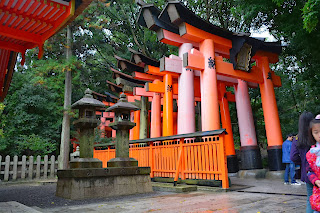Tokyo has been the capital of Japan for 150 years and before that, Kyoto was the capital for over 1000 years. But the first capital was Nara, a small city south of Kyoto. Although it was the capital for only 75 years, the "Nara Period" in the 8th century was an important period. Buddhism, imported from Korea and China, rose to dominance. Chinese characters were adopted for the writing of the Japanese language, and many other Chinese customs were adopted, including the grid pattern of the streets of Nara.
Buddhism thrived and there was a flurry of temple-building. Many of these temples survive because they were built of wood. Earthquakes are a frequent occurrence in Japan and wood construction survives better than stone or masonry. Wood is flexible, and when properly assembles, bends rather than breaks when earthquakes strike. (The city walls and stone temples built by the Greeks in Asia Minor were grand and impressive, but many a city was devastated by earthquakes in antiquity, some so badly damaged that they had to be abandoned.)
But even the best construction seldom survives war. By being the capital for only 75 years, Nara escaped the periods of civil war that devastated Kyoto. And, it was not bombed by the Allies during World War II. So today, Nara can claim to have the oldest building in the world and the world's largest wooden building.
The Buddhist priests of Nara were nothing if not bold. The largest building was built because they needed to house the largest bronze Buddha in the world. This is the Daibutsu, the Great Buddha. It is 49 feet high and made from 500 tons of bronze and almost 300 pounds of gold. It was made in 751.
It is truly impressive. Just to give some perspective, the eyes are about 3 feet wide.
The statue has had some trauma over the years, being damaged by earthquakes and fire. Parts of it have been re-cast, but that doesn't lessen the impact of the statue.
There is a halo of smaller buddhas surrounding the statue; the ones higher on the wall are slightly larger than the ones lower. This permits all of them to appear of a similar size when viewed from below.
In addition to the Great Buddha there are two bodhisattva, enlightened beings who want to help other beings attain enlightenment. (Each are about 20 feet high.) People pray to one of them, the Kokuzo Bosatsu, to improve their memory, technical skills and artistic talents. According to the Japan Times, if you recite the Kokuzo mantra one million times, you will be able to "memorize all the thousands of Shingon Buddhist texts. It’s no wonder children in Japan sometimes pray to Kokuzo for academic success and to improve their memories."
Finally, there are two giant guardians of the Buddha. They are two of the four Heavenly Kings who watch over each of the four cardinal directions. This one, Komoku-ten, is a fierce warrior whose weapons are a scroll and a pen. Perhaps the pen is mightier than the sword.
For more pictures of this temple, see Daibutsu, the Great Buddha.
Buddhism thrived and there was a flurry of temple-building. Many of these temples survive because they were built of wood. Earthquakes are a frequent occurrence in Japan and wood construction survives better than stone or masonry. Wood is flexible, and when properly assembles, bends rather than breaks when earthquakes strike. (The city walls and stone temples built by the Greeks in Asia Minor were grand and impressive, but many a city was devastated by earthquakes in antiquity, some so badly damaged that they had to be abandoned.)
But even the best construction seldom survives war. By being the capital for only 75 years, Nara escaped the periods of civil war that devastated Kyoto. And, it was not bombed by the Allies during World War II. So today, Nara can claim to have the oldest building in the world and the world's largest wooden building.
 |
| Daibutsu-den Hall, Nara. Note the relative size of the people in the photo. |
It is truly impressive. Just to give some perspective, the eyes are about 3 feet wide.
The statue has had some trauma over the years, being damaged by earthquakes and fire. Parts of it have been re-cast, but that doesn't lessen the impact of the statue.
There is a halo of smaller buddhas surrounding the statue; the ones higher on the wall are slightly larger than the ones lower. This permits all of them to appear of a similar size when viewed from below.
In addition to the Great Buddha there are two bodhisattva, enlightened beings who want to help other beings attain enlightenment. (Each are about 20 feet high.) People pray to one of them, the Kokuzo Bosatsu, to improve their memory, technical skills and artistic talents. According to the Japan Times, if you recite the Kokuzo mantra one million times, you will be able to "memorize all the thousands of Shingon Buddhist texts. It’s no wonder children in Japan sometimes pray to Kokuzo for academic success and to improve their memories."
 |
| Kokuzo Bosatsu |
Finally, there are two giant guardians of the Buddha. They are two of the four Heavenly Kings who watch over each of the four cardinal directions. This one, Komoku-ten, is a fierce warrior whose weapons are a scroll and a pen. Perhaps the pen is mightier than the sword.
 |
| Komoku-ten |
For more pictures of this temple, see Daibutsu, the Great Buddha.





























































